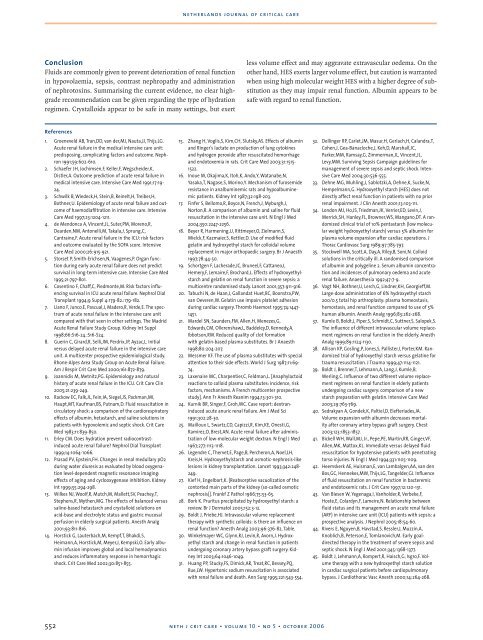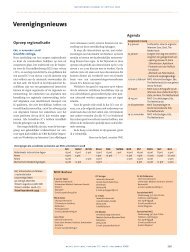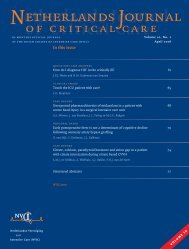Netherlands Journal
NJCC Volume 10, Oktober 2006
NJCC Volume 10, Oktober 2006
- No tags were found...
Create successful ePaper yourself
Turn your PDF publications into a flip-book with our unique Google optimized e-Paper software.
netherlands journal of critical care<br />
Conclusion<br />
Fluids are commonly given to prevent deterioration of renal function<br />
in hypovolaemia, sepsis, contrast nephropathy and administration<br />
of nephrotoxins. Summarising the current evidence, no clear highgrade<br />
recommendation can be given regarding the type of hydration<br />
regimen. Crystalloids appear to be safe in many settings, but exert<br />
less volume effect and may aggravate extravascular oedema. On the<br />
other hand, HES exerts larger volume effect, but caution is warranted<br />
when using high molecular weight HES with a higher degree of substitution<br />
as they may impair renal function. Albumin appears to be<br />
safe with regard to renal function.<br />
References<br />
1. Groeneveld AB, Tran,DD, van der,MJ, Nauta,JJ, Thijs,LG.<br />
Acute renal failure in the medical intensive care unit:<br />
predisposing, complicating factors and outcome. Nephron<br />
1991;59:602-610.<br />
2. Schaefer JH, Jochimsen,F, Keller,F, Wegscheider,K,<br />
Distler,A. Outcome prediction of acute renal failure in<br />
medical intensive care. Intensive Care Med 1991;17:19-<br />
24.<br />
3. Schwilk B, Wiedeck,H, Stein,B, Reinelt,H, Treiber,H,<br />
Bothner,U. Epidemiology of acute renal failure and outcome<br />
of haemodiafiltration in intensive care. Intensive<br />
Care Med 1997;23:1204-1211.<br />
4. de Mendonca A, Vincent,JL, Suter,PM, Moreno,R,<br />
Dearden,NM, Antonelli,M, Takala,J, Sprung,C,<br />
Cantraine,F. Acute renal failure in the ICU: risk factors<br />
and outcome evaluated by the SOFA score. Intensive<br />
Care Med 2000;26:915-921.<br />
5. Storset P, Smith-Erichsen,N, Vaagenes,P. Organ function<br />
during early acute renal failure does not predict<br />
survival in long-term intensive care. Intensive Care Med<br />
1995;21:797-801.<br />
6. Cosentino F, Chaff,C, Piedmonte,M. Risk factors influencing<br />
survival in ICU acute renal failure. Nephrol Dial<br />
Transplant 1994;9 Suppl 4:179-82.:179-182.<br />
7. Liano F, Junco,E, Pascual,J, Madero,R, Verde,E. The spectrum<br />
of acute renal failure in the intensive care unit<br />
compared with that seen in other settings. The Madrid<br />
Acute Renal Failure Study Group. Kidney Int Suppl<br />
1998;66:S16-24.:S16-S24.<br />
8. Guerin C, Girard,R, Selli,JM, Perdrix,JP, Ayzac,L. Initial<br />
versus delayed acute renal failure in the intensive care<br />
unit. A multicenter prospective epidemiological study.<br />
Rhone-Alpes Area Study Group on Acute Renal Failure.<br />
Am J Respir Crit Care Med 2000;161:872-879.<br />
9. Joannidis M, Metnitz,PG. Epidemiology and natural<br />
history of acute renal failure in the ICU. Crit Care Clin<br />
2005;21:239-249.<br />
10. Rackow EC, Falk,JL, Fein,IA, Siegel,JS, Packman,MI,<br />
Haupt,MT, Kaufman,BS, Putnam,D. Fluid resuscitation in<br />
circulatory shock: a comparison of the cardiorespiratory<br />
effects of albumin, hetastarch, and saline solutions in<br />
patients with hypovolemic and septic shock. Crit Care<br />
Med 1983;11:839-850.<br />
11. Erley CM. Does hydration prevent radiocontrastinduced<br />
acute renal failure? Nephrol Dial Transplant<br />
1999;14:1064-1066.<br />
12. Prasad PV, Epstein,FH. Changes in renal medullary pO2<br />
during water diuresis as evaluated by blood oxygenation<br />
level-dependent magnetic resonance imaging:<br />
effects of aging and cyclooxygenase inhibition. Kidney<br />
Int 1999;55:294-298.<br />
13. Wilkes NJ, Woolf,R, Mutch,M, Mallett,SV, Peachey,T,<br />
Stephens,R, Mythen,MG. The effects of balanced versus<br />
saline-based hetastarch and crystalloid solutions on<br />
acid-base and electrolyte status and gastric mucosal<br />
perfusion in elderly surgical patients. Anesth Analg<br />
2001;93:811-816.<br />
14. Horstick G, Lauterbach,M, Kempf,T, Bhakdi,S,<br />
Heimann,A, Horstick,M, Meyer,J, Kempski,O. Early albumin<br />
infusion improves global and local hemodynamics<br />
and reduces inflammatory response in hemorrhagic<br />
shock. Crit Care Med 2002;30:851-855.<br />
15. Zhang H, Voglis,S, Kim,CH, Slutsky,AS. Effects of albumin<br />
and Ringer’s lactate on production of lung cytokines<br />
and hydrogen peroxide after resuscitated hemorrhage<br />
and endotoxemia in rats. Crit Care Med 2003;31:1515-<br />
1522.<br />
16. Inoue M, Okajima,K, Itoh,K, Ando,Y, Watanabe,N,<br />
Yasaka,T, Nagase,S, Morino,Y. Mechanism of furosemide<br />
resistance in analbuminemic rats and hypoalbuminemic<br />
patients. Kidney Int 1987;32:198-203.<br />
17. Finfer S, Bellomo,R, Boyce,N, French,J, Myburgh,J,<br />
Norton,R. A comparison of albumin and saline for fluid<br />
resuscitation in the intensive care unit. N Engl J Med<br />
2004;350:2247-2256.<br />
18. Beyer R, Harmening,U, Rittmeyer,O, Zielmann,S,<br />
Mielck,F, Kazmaier,S, Kettler,D. Use of modified fluid<br />
gelatin and hydroxyethyl starch for colloidal volume<br />
replacement in major orthopaedic surgery. Br J Anaesth<br />
1997;78:44-50.<br />
19. Schortgen F, Lacherade,JC, Bruneel,F, Cattaneo,I,<br />
Hemery,F, Lemaire,F, Brochard,L. Effects of hydroxyethylstarch<br />
and gelatin on renal function in severe sepsis: a<br />
multicentre randomised study. Lancet 2001;357:911-916.<br />
20. Tabuchi N, de Haan,J, Gallandat Huet,RC, Boonstra,PW,<br />
van Oeveren,W. Gelatin use impairs platelet adhesion<br />
during cardiac surgery. Thromb Haemost 1995;74:1447-<br />
1451.<br />
21. Mardel SN, Saunders,FM, Allen,H, Menezes,G,<br />
Edwards,CM, Ollerenshaw,L, Baddeley,D, Kennedy,A,<br />
Ibbotson,RM. Reduced quality of clot formation<br />
with gelatin-based plasma substitutes. Br J Anaesth<br />
1998;80:204-207.<br />
22. Messmer KF. The use of plasma substitutes with special<br />
attention to their side effects. World J Surg 1987;11:69-<br />
74.<br />
23. Laxenaire MC, Charpentier,C, Feldman,L. [Anaphylactoid<br />
reactions to colloid plasma substitutes: incidence, risk<br />
factors, mechanisms. A French multicenter prospective<br />
study]. Ann Fr Anesth Reanim 1994;13:301-310.<br />
24. Kurnik BR, Singer,F, Groh,WC. Case report: dextraninduced<br />
acute anuric renal failure. Am J Med Sci<br />
1991;302:28-30.<br />
25. Mailloux L, Swartz,CD, Capizzi,R, Kim,KE, Onesti,G,<br />
Ramirez,O, Brest,AN. Acute renal failure after administration<br />
of low-molecular weight dextran. N Engl J Med<br />
1967;277:1113-1118.<br />
26. Legendre C, Thervet,E, Page,B, Percheron,A, Noel,LH,<br />
Kreis,H. Hydroxyethylstarch and osmotic-nephrosis-like<br />
lesions in kidney transplantation. Lancet 1993;342:248-<br />
249.<br />
27. Kief H, Engelbart,K. [Reabsorptive vacuolization of the<br />
contorted main parts of the kidney (so-called osmotic<br />
nephrosis)]. Frankf Z Pathol 1966;75:53-65.<br />
28. Bork K. Pruritus precipitated by hydroxyethyl starch: a<br />
review. Br J Dermatol 2005;152:3-12.<br />
29. Boldt J, Priebe,HJ. Intravascular volume replacement<br />
therapy with synthetic colloids: is there an influence on<br />
renal function? Anesth Analg 2003;96:376-82, Table.<br />
30. Winkelmayer WC, Glynn,RJ, Levin,R, Avorn,J. Hydroxyethyl<br />
starch and change in renal function in patients<br />
undergoing coronary artery bypass graft surgery. Kidney<br />
Int 2003;64:1046-1049.<br />
31. Huang PP, Stucky,FS, Dimick,AR, Treat,RC, Bessey,PQ,<br />
Rue,LW. Hypertonic sodium resuscitation is associated<br />
with renal failure and death. Ann Surg 1995;221:543-554.<br />
32. Dellinger RP, Carlet,JM, Masur,H, Gerlach,H, Calandra,T,<br />
Cohen,J, Gea-Banacloche,J, Keh,D, Marshall,JC,<br />
Parker,MM, Ramsay,G, Zimmerman,JL, Vincent,JL,<br />
Levy,MM. Surviving Sepsis Campaign guidelines for<br />
management of severe sepsis and septic shock. Intensive<br />
Care Med 2004;30:536-555.<br />
33. Dehne MG, Muhling,J, Sablotzki,A, Dehne,K, Sucke,N,<br />
Hempelmann,G. Hydroxyethyl starch (HES) does not<br />
directly affect renal function in patients with no prior<br />
renal impairment. J Clin Anesth 2001;13:103-111.<br />
34. London MJ, Ho,JS, Triedman,JK, Verrier,ED, Levin,J,<br />
Merrick,SH, Hanley,FL, Browner,WS, Mangano,DT. A randomized<br />
clinical trial of 10% pentastarch (low molecular<br />
weight hydroxyethyl starch) versus 5% albumin for<br />
plasma volume expansion after cardiac operations. J<br />
Thorac Cardiovasc Surg 1989;97:785-797.<br />
35. Stockwell MA, Scott,A, Day,A, Riley,B, Soni,N. Colloid<br />
solutions in the critically ill. A randomised comparison<br />
of albumin and polygeline 2. Serum albumin concentration<br />
and incidences of pulmonary oedema and acute<br />
renal failure. Anaesthesia 1992;47:7-9.<br />
36. Vogt NH, Bothner,U, Lerch,G, Lindner,KH, Georgieff,M.<br />
Large-dose administration of 6% hydroxyethyl starch<br />
200/0.5 total hip arthroplasty: plasma homeostasis,<br />
hemostasis, and renal function compared to use of 5%<br />
human albumin. Anesth Analg 1996;83:262-268.<br />
37. Kumle B, Boldt,J, Piper,S, Schmidt,C, Suttner,S, Salopek,S.<br />
The influence of different intravascular volume replacement<br />
regimens on renal function in the elderly. Anesth<br />
Analg 1999;89:1124-1130.<br />
38. Allison KP, Gosling,P, Jones,S, Pallister,I, Porter,KM. Randomized<br />
trial of hydroxyethyl starch versus gelatine for<br />
trauma resuscitation. J Trauma 1999;47:1114-1121.<br />
39. Boldt J, Brenner,T, Lehmann,A, Lang,J, Kumle,B,<br />
Werling,C. Influence of two different volume replacement<br />
regimens on renal function in elderly patients<br />
undergoing cardiac surgery: comparison of a new<br />
starch preparation with gelatin. Intensive Care Med<br />
2003;29:763-769.<br />
40. Sedrakyan A, Gondek,K, Paltiel,D, Elefteriades,JA.<br />
Volume expansion with albumin decreases mortality<br />
after coronary artery bypass graft surgery. Chest<br />
2003;123:1853-1857.<br />
41. Bickell WH, Wall,MJ, Jr., Pepe,PE, Martin,RR, Ginger,VF,<br />
Allen,MK, Mattox,KL. Immediate versus delayed fluid<br />
resuscitation for hypotensive patients with penetrating<br />
torso injuries. N Engl J Med 1994;331:1105-1109.<br />
42. Heemskerk AE, Huisman,E, van Lambalgen,AA, van den<br />
Bos,GC, Hennekes,MW, Thijs,LG, Tangelder,GJ. Influence<br />
of fluid resuscitation on renal function in bacteremic<br />
and endotoxemic rats. J Crit Care 1997;12:120-131.<br />
43. Van Biesen W, Yegenaga,I, Vanholder,R, Verbeke,F,<br />
Hoste,E, Colardyn,F, Lameire,N. Relationship between<br />
fluid status and its management on acute renal failure<br />
(ARF) in intensive care unit (ICU) patients with sepsis: a<br />
prospective analysis. J Nephrol 2005;18:54-60.<br />
44. Rivers E, Nguyen,B, Havstad,S, Ressler,J, Muzzin,A,<br />
Knoblich,B, Peterson,E, Tomlanovich,M. Early goaldirected<br />
therapy in the treatment of severe sepsis and<br />
septic shock. N Engl J Med 2001;345:1368-1377.<br />
45. Boldt J, Lehmann,A, Rompert,R, Haisch,G, Isgro,F. Volume<br />
therapy with a new hydroxyethyl starch solution<br />
in cardiac surgical patients before cardiopulmonary<br />
bypass. J Cardiothorac Vasc Anesth 2000;14:264-268.<br />
552<br />
neth j crit care • volume 10 • no 5 • october 2006







